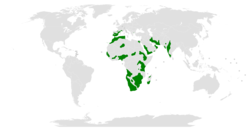Biology:Trithemis kirbyi
| Trithemis kirbyi | |
|---|---|

| |
| Male, Tsumeb, Namibia | |
| Scientific classification | |
| Domain: | Eukaryota |
| Kingdom: | Animalia |
| Phylum: | Arthropoda |
| Class: | Insecta |
| Order: | Odonata |
| Infraorder: | Anisoptera |
| Family: | Libellulidae |
| Genus: | Trithemis |
| Species: | T. kirbyi
|
| Binomial name | |
| Trithemis kirbyi Selys, 1891
| |

| |
| Range of Trithemis kirbyi | |
| Synonyms | |
| |
Trithemis kirbyi,[2] also known as the Kirby's dropwing[1], orange-winged dropwing,[1] or scarlet rock glider[3][4] is a species of dragonfly in the family Libellulidae.[1]
Distribution
It is found in Algeria, Angola, Benin, Botswana, Burkina Faso, Chad, Comoros, the Democratic Republic of the Congo, Ivory Coast, Egypt, Ethiopia, Gambia, Ghana, Guinea, Kenya, Liberia, Madagascar , Malawi, Morocco, Mozambique, Namibia, Nigeria, Senegal, Somalia, South Africa , Sudan, Tanzania, Togo, Uganda, Western Sahara, Zambia, Zimbabwe, and possibly Burundi. It is also present in southern Europe, the Arabian Peninsula, the Indian Ocean Islands and South Asia to India .[1][5]
Since 2003 this African tropical dragonfly has been colonizing Europe helped by a widespread increase in temperatures. It is now breeding successfully in Spain , Portugal and France .
Description and ecology
The adult male abdomen measures 21–24 mm and hind wing 24–27 mm. Female abdomen measures 23 mm and hind wing 26–30 mm. The male is a medium-sized scarlet dragonfly with a broad reddish amber patch on the base of transparent wings. The female is similar to the male, but duller in color.[3] Its natural habitats are subtropical or tropical streams and rivers. It breeds in marshes, ponds, and lakes, and prefers to perch on exposed rocks, dry areas, and boulders in riverbeds.[6][7][8][3][4]
References
- ↑ 1.0 1.1 1.2 1.3 1.4 Boudot, J.-P.; Clausnitzer, V.; Samraoui, B.; Suhling, F.; Dijkstra, K.-D.B.; Schneider, W. (2016). "Trithemis kirbyi". IUCN Red List of Threatened Species 2016: e.T60062A83875068. doi:10.2305/IUCN.UK.2016-3.RLTS.T60062A83875068.en. https://www.iucnredlist.org/species/60062/83875068. Retrieved 17 November 2021.
- ↑ "World Odonata List". University of Puget Sound. https://www.pugetsound.edu/academics/academic-resources/slater-museum/biodiversity-resources/dragonflies/world-odonata-list2/.
- ↑ 3.0 3.1 3.2 "Trithemis kirbyi Selys, 1891". India Biodiversity Portal. http://indiabiodiversity.org/species/show/266713.
- ↑ 4.0 4.1 "Trithemis kirbyi Selys, 1891". Odonata of India, v. 1.00. Indian Foundation for Butterflies. http://www.indianodonata.org/sp/647/Trithemis-kirbyi.
- ↑ K.A., Subramanian; K.G., Emiliyamma; R., Babu; C., Radhakrishnan; S.S., Talmale (2018). Atlas of Odonata (Insecta) of the Western Ghats, India. Zoological Survey of India. pp. 393–394. ISBN 9788181714954.
- ↑ Subramanian, K. A. (2005). Dragonflies and Damselflies of Peninsular India. http://www.ias.ac.in/initiat/sci_ed/lifescape/odonates-dragonflies.pdf.
- ↑ C FC Lt. Fraser (1936). The Fauna of British India, including Ceylon and Burma, Odonata Vol. III. Red Lion Court, Fleet Street, London: Taylor and Francis. pp. 385–387. https://archive.org/details/FraserOdonata3.
- ↑ C FC Lt. Fraser (1924). A Survey of the Odonate (Dragonfly) Fauna of Western India and Descriptions of Thirty New Species. pp. 439–440. http://faunaofindia.nic.in/PDFVolumes/records/026/05/0423-0522.pdf.
External links
Wikidata ☰ Q1302218 entry
 |






